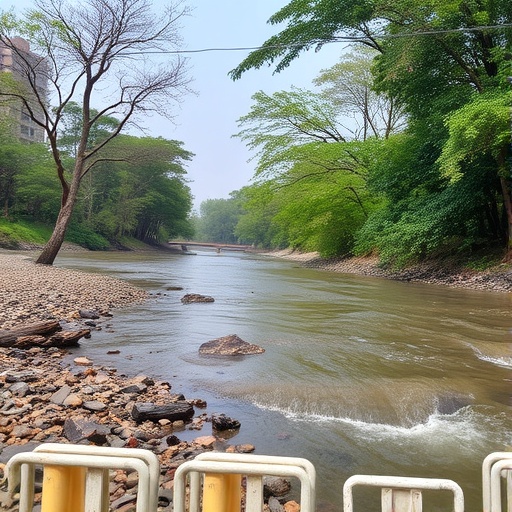In recent years, there has been increasing concern regarding water quality and ecological integrity within critical habitats across the globe. One significant study sheds light on these pressing issues as it investigates the physico-chemical parameters, levels of 2,4-D herbicide, estrogen hormones, and metal concentrations in the Santo Antônio River, which runs through a region that borders Brazil and Argentina. The findings of this research are crucial as they not only indicate the current state of waterways but also underscore the potential risks posed to the surrounding ecosystems and human populations relying on these water sources.
The Santo Antônio River, which traverses both Brazil and Argentina, is crucial to the region’s biodiversity and serves as a vital resource for local communities. However, the growing agricultural activities in the surrounding areas have raised alarms about the potential infiltration of pollutants, particularly pesticides, that could compromise the health of this river system. 2,4-D, a commonly used herbicide, has been extensively studied for its environmental impacts, and its presence in freshwater ecosystems is a growing concern among environmental scientists.
The methodology employed in this study is comprehensive and systematic, designed to collect accurate data on various physicochemical parameters of the Santo Antônio River. Researchers collected water samples at multiple locations along the river, enabling a robust analysis of the composition and quality of the water. Key parameters, including pH levels, electrical conductivity, and dissolved oxygen, were meticulously recorded. These measures help determine the overall health of aquatic habitats and the potential for sustaining fish and other wildlife populations.
In addition to basic water quality indicators, the study focused on the detection and quantification of 2,4-D and estrogen hormones within the river. These substances are particularly concerning because they can disrupt endocrine systems in both aquatic organisms and humans, leading to severe ecological and health ramifications. The presence of estrogen hormones can be linked to the proliferation of reproductive abnormalities in fish and other aquatic species, raising alarms about the long-term viability of these populations and the food chain overall.
Researchers also analyzed metal concentrations, as heavy metals are notorious for accumulating in aquatic systems and causing toxic effects in marine life. Metals such as lead, mercury, and cadmium pose serious threats not just to aquatic organisms, but also to human health, particularly when contaminated water is used for drinking or irrigation. The findings underscore the urgency for monitoring and managing these hazardous substances in freshwater systems, especially in regions where agricultural runoff may contribute to elevated levels of pollution.
The implications of these findings are multidimensional. They highlight the importance of understanding how anthropogenic activities impact freshwater ecosystems and the direct consequences on human health and biodiversity. Furthermore, the study advocates for tighter regulations around pesticide usage in agricultural practices, particularly near vulnerable waterways. This research serves as a compelling call to action for policymakers and environmentalists alike, urging for collaborative efforts toward the sustainable management of these vital water resources.
As global populations continue to expand and agricultural practices intensify, the risks associated with water pollution are likely to increase. The study of the Santo Antônio River is a stark reminder of the delicate balance that exists between human activities and nature’s ability to self-regulate. It also opens the door for further research into remedial measures that can mitigate the impacts of pollutants in similar freshwater ecosystems across the world.
Future research should focus on longitudinal studies that track changes over time, assessing the effectiveness of mitigation strategies and the resilience of ecosystems to recover from human-induced pollution. For instance, restoring riparian buffers, implementing stricter agricultural runoff regulations, and promoting sustainable farming practices can substantially enhance water quality and aquatic health.
Public awareness also plays a crucial role in driving change. Educating local communities about the sources and effects of water pollution is vital. By empowering residents with knowledge, they can act as stewards of their local environment, advocating for cleaner water and healthier ecosystems.
Access to clean and safe water is not merely an environmental issue; it is a human right that affects health, food security, and overall quality of life. Governments, environmental organizations, and communities must collaborate to implement sustainable practices that ensure freshwater resources are preserved for future generations while also maintaining the delicate ecological balance necessary for all forms of life.
The ongoing assessment of water quality in the Santo Antônio River serves as a crucial example of what is at stake when environmental health is neglected. As the impacts of climate change and industrial activities grow more pervasive, continuous monitoring will be essential in understanding and mitigating these challenges. By elevating this research into public discourse and policy, a foundation can be laid toward the restoration and protection of critical freshwater ecosystems.
In summary, the recent study of the Santo Antônio River highlights a pressing issue impacting both environmental and human health in this bi-national region. The need to address the contamination from 2,4-D herbicides, metals, and hormonal disruptors is paramount in ensuring the viability of natural resources that support wildlife and human populations alike. Through concerted efforts in research, public awareness, and regulatory measures, we can work toward a future where waterways are not viewed merely as resources to be exploited but as vital ecosystems worthy of preservation and care.
Subject of Research: Physicochemical parameters, levels of 2,4-D, estrogen hormones, and metals in the Santo Antônio River
Article Title: Physicochemical parameters, levels of 2,4-D, estrogen hormones, and metals in Santo Antônio River (Brazil-Argentina): ecotoxicity and effect on water quality of the Iguaçu National Park
Article References:
Oliveira, A.K.G., de Souza, C.A., do Vale Silva, E. et al. Physicochemical parameters, levels of 2,4-D, estrogen hormones, and metals in Santo Antônio River (Brazil-Argentina): ecotoxicity and effect on water quality of the Iguaçu National Park.
Environ Sci Pollut Res (2025). https://doi.org/10.1007/s11356-025-37180-y
Image Credits: AI Generated
DOI: https://doi.org/10.1007/s11356-025-37180-y
Keywords: water quality, ecotoxicity, 2,4-D, hormones, heavy metals, Santo Antônio River, environmental health, sustainable practices, biodiversity




